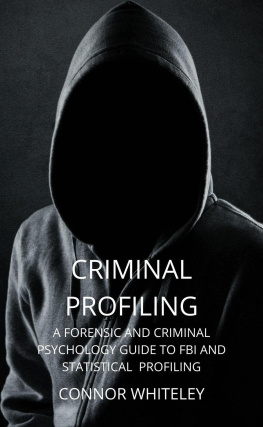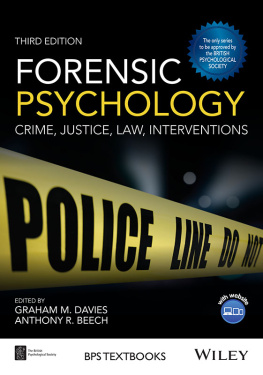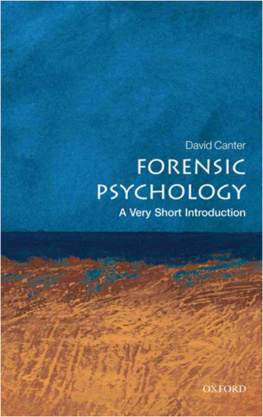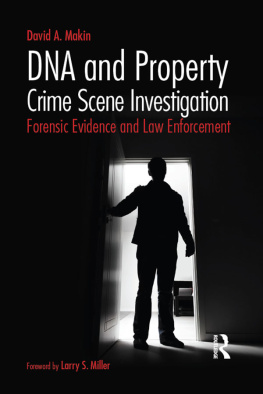Published by
World Scientific Publishing Co. Pte. Ltd.
5 Toh Tuck Link, Singapore 596224
USA office: 27 Warren Street, Suite 401-402, Hackensack, NJ 07601
UK office: 57 Shelton Street, Covent Garden, London WC2H 9HE
Library of Congress Cataloging-in-Publication Data
Names: Khader, Majeed, 1966 author.
Title: Crime and behaviour : an introduction to criminal and forensic psychology / Majeed Khader, Ministry of Home Affairs, Singapore & Home Team Behavioural Sciences Center, Singapore & Nanyang Technological University, Singapore.
Other titles: Crime and behavior
Description: New Jersey : World Scientific, [2018]
Identifiers: LCCN 2018049593 | ISBN 9789813279339 (hardcover)
Subjects: LCSH: Criminal justice, Administration of--Singapore. | Criminal investigation--Singapore. | Crime prevention--Singapore. | Forensic psychology--Singapore.
Classification: LCC HV9960.S56 K43 2018 | DDC 364.3--dc23
LC record available at https://lccn.loc.gov/2018049593
British Library Cataloguing-in-Publication Data
A catalogue record for this book is available from the British Library.
Copyright 2019 by A. Majeed B. A. Khader
All rights reserved.
For any available supplementary material, please visit
https://www.worldscientific.com/worldscibooks/10.1142/11244#t=suppl
Desk Editor: Karimah Samsudin
Typeset by Stallion Press
Email:
Printed in Singapore
ACKNOWLEDGEMENTS
This book has been a personal endeavour to provide a text for my students. As Singaporeans, they found it limiting to use American, Canadian, and British criminal psychology textbooks, even though much of the theoretical content was still useful. Their laws and contexts differed from ours. I also typically receive one or two emails a week asking about criminal psychology or criminology career prospects. All of these hinted that there was fast growing interest in this subject and that there was a need for local material. Hence, the reason for this book.
Readers should note that I have not been asked to write this for any organisation. I write it because of a conviction that the Singapore model works. The Singapore crime management model is not a perfect one. It need not be. It just needs to be a model that works for most Singaporeans and for Singapore.
I am grateful, however, for the support provided by the Singapore Police and the Ministry of Home Affairs, as this project commenced during a sabbatical I took from work. My present and past leaders have been very supportive of the need to do research. I am thankful towards Mr. Pang Kin Keong, Mr. Leo Yip, Mr. Tan Tee How, Madam Goh Soon Poh, Mr. Phua Kok Keong, Mr. T. Rajakumar, and Mr. Hoong Wee Teck. I am particularly grateful for the guidance of Mr. Benny Lim, who has reminded me to do it right and do it well.
My past supervisors, Mr. Jerry See, Mr. Loy Chye Meng, Mr. Ng Boon Gay, Mr. Tan Hung Hooi, Mr. Dennis Tang, Mr. Ng Seng Liang, Mr. Goh Liang Kwang, Mr. Khoo Boon Hui and Mr. Soh Kee Hean have been very supportive and I thank them too.
Starting off as a pioneering police psychologist was not easy. There were no senior psychologists to guide you. Many police officers, however, guided me. I am thankful therefore to Ng Bah Tee, Sri Kanthan, C.V. Gabriel, Mickey Lee, Chan Soo Wah, Simon Suppiah, Ang Hin Kee, and Haffidz Abdul Hamid. To Burhanudeen Haji Hussainar, Goh Tat Boon, Dominique Ngoo, Raymond Tan, Roy Lim, and Osman Bin Mohamad Noor, a heart-warming thanks for discussions on investigative and profiling matters.
To my ever-supportive close friends and police officer colleagues: Devrajan Bala, David Scott Arul, Jarrod Pereira, Daniel Tan, Lee Su Peng, Sekher Warrier, Abdul Jalil, and Gerald Lim, I have been privileged to work alongside with you over these 25 years.
Developing as a psychologist, I learnt much from Singaporean giants and senior colleagues: Associate Professor Fred Long Foo Yee, Mr. Ong Kian Chye, Associate Professor John Elliot, Professor David Chan, Dr. Lyn Chua, Professor Chong Siow Ann, Elizabeth Pang, Susan Sim, and Vivienne Ng.
At Nanyang Technological University, I got warm support from Associate Professor Ringo Ho, Associate Professor Joyce Pang, Professor Annabel Chen, Professor Adrian Raine, Assistant Professor Olivia Choy, Associate Professor Kumar Ramakrishna, Dr. Damien Cheong and Dr. Shashi Jayakumar.
Internationally, Emeritus Professor Rhona Flin, Professor Amina Memon, Professor Ray Bull, Professor Laurence Alison, Professor Rebecca Milne, Master Rachel Spearing, Professor Clive Hollin, Professor Kate Fritzon, Professor Graham Davies, Mr. Lee Rainbow, and Professor Mark Kebbell have been wonderful supportive mentors and friends. Much thanks to my friends at the U.S.-based Society of Police and Criminal Psychology; Dr. Gary Aumiller, Professor Michael Stoloff and Professor JoAnne Brewster. All of you have my deep gratitude.
I also owe much to my colleagues at the Police Psychological Services Division, and Home Team Behavioural Sciences Centre. My deep appreciation to Jeffery Chin, Carolyn Misir, Whistine Chai, Gabriel Ong, Jansen Ang, and Tim Leo, with whom I have had many discussions on crime psychology. Especially, to Neo Loo Seng for his insights on the Terrorism chapter. I must also acknowledge the assistance of my research assistants, Rachel Ng Li En and Loh Ying Hui.
Working with Karimah Samsudin at WSPC has also been a smooth journey, which made this project so much easier. She has been patient, encouraging, and professional in guiding me.
I am thankful for the blessings of my mum Hawa and brothers Firoz and Mohideen. Although he is no longer with us, as I wrote this, I was inspired by what my dad Othmansa Abdul Khader would have said to cheer me on. My children, Tasneem and Raouf, have been my joy. Most importantly, to Tscheng Yee, who has been a source of emotional support, clever ideas, and critical feedback.













